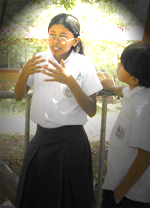Deaf children reveal the brain's ability to break down ideas into components

A group of deaf children from Nicaragua, who created their own sign language, are giving linguists a rare glimpse into the birth of a language. The children teach the linguists how the ability to learn a language is inherent in our minds.
For years the debate has been going on as to whether our mind is like an empty notebook, which can absorb any language structure we are exposed to, or whether grammatical rules are embedded in our minds. The existing languages share basic rules, but the reason for this may lie in the mutual influence between the different languages in their stages of development.
Linguists try to answer this question by studying languages in their early stages of development. For example, when people who speak different languages gather together, as a result of migration or a period of slavery for example, they quickly develop a mixed dialect, which over the years will be refined into a more sophisticated mixed language.
However, in these cases the communication is based on existing languages. The children from Nicaragua are special in this regard, because they created a language from nothing. The deaf children in this country lived in virtual isolation until they were brought to special schools in the late 1970s and early 1980s.
As soon as the deaf children started to mingle, they started communicating with each other in their free time using hand gestures. Children usually tend to stick to the signs they have acquired until they reach adulthood, so the oldest children use relatively crude gestures. However, the younger generations continue to refine the gestures and develop the new language, which has its own grammatical rules.
Anne Senghas from Columbia University in New York, United States, has been researching the group's sign language since 1990. She believes that the way language develops reveals some secrets about how our brain is wired.
In her latest study, published in Science, Sanges explored a feature, characteristic of most sign languages and spoken languages in the world, whereby phrases are composed of smaller discrete units. For example, if we say that the book was published, we use two words "published" and "published" to describe one action. This way we gain a rich and flexible vocabulary, which can be mixed and created expressions to describe other events.
Sanges asked speakers of the language of different ages to tell a story. She found that the second generation of children, speaking the new Nicaraguan language, had a similar system of assembly. Instead of creating one sign for "Isa Laur", the children attached two different gestures.
The findings raise the possibility that children are born with a natural talent for breaking down languages in this way, a fact that helps explain why it is so easy to acquire a new language.
"This is a dramatic example of how untaught this whole thing is," says Leila Gleitman, who studies language acquisition at the University of Pennsylvania in Philadelphia, United States.
It is still unclear whether this ability to break down ideas into components is unique to language, or whether it is part of a broader ability that can be applied to other learning skills.
The real beauty of the study, linguists say, is that it shows how children create language from scratch and adapt to it so quickly. "You would think that it takes years and years of evolution, and then suddenly one language takes shape in one generation," Sanges says. "It's pretty amazing."
Translation: Dikla Oren
